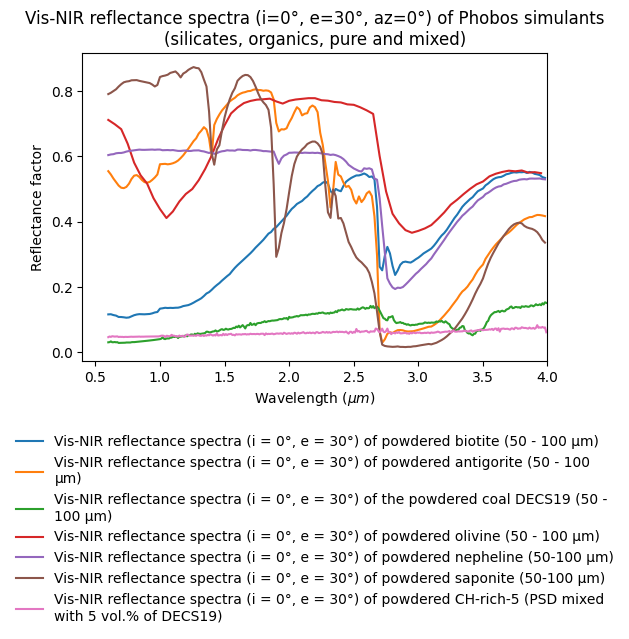- Title
- Vis-NIR reflectance spectra (i=0°, e=30°, az=0°) of Phobos simulants (silicates, organics, pure and mixed)
- DOI
- 10.26302/SSHADE/EXPERIMENT_LB_20240713_001
- Data reference
- Wargnier, Antonin; Poch, Olivier; Beck, Pierre (2022): Vis-NIR reflectance spectra (i=0°, e=30°, az=0°) of Phobos simulants (silicates, organics, pure and mixed). SSHADE/GhoSST (OSUG Data Center). Dataset/Spectral Data. https://doi.org/10.26302/SSHADE/EXPERIMENT_LB_20240713_001
- Publications
- Database(s)
- Experimentalists
- Type(s)
- laboratory measurement
- Description
- Vis-NIR (0.6-4.2 µm) reflectance spectra (i=0°, e=30°, az=0°) acquired with the SHADOWS instrument of several mixtures and endmembers used as Phobos simulants
- Number of spectra
- 27
- Variable type(s)
-
- sample composition
- Instrument
- SHADOWS Spectro-Gonio bidirectional reflection Vis-NIR
- Sample holder
- open sample holder (13 mm diameter, 2 mm deep) in anodized aluminum (not blackened)
- Standard medium
- air
- Observation mode
- spectrum
- Spectral range type(s)
- Vis, NIR
- Valid spectral range(s)
-
Min - Max (${\mu}m$) Sampling (${\mu}m$) Resolution (${\mu}m$) Position accuracy (${\mu}m$) Absorption edge #1 0.6 - 0.68 0.02 0.003 #2 0.7 - 1.58 0.02 0.006 #3 1.6 - 2.82 0.02 0.013 #4 2.84 - 4.2 0.02 0.026 - Comments
- Measured over the 380-4500 nm range?
Definition: incidence and emergence angles are positive with origin at nadir, and vary in same direction. Azimuth origin (increasing clockwise) is for i = e (opposition geometry).
- Observation geometry
- bidirectional
- Observation mode
- fixed angles
- Incidence angle
- 0.0°
- Emergence angle
- 30.0°
- Azimuth angle
- 0.0°
- Phase angle
- 30.0°
Illumination
Observation
- Comments
- partial polarization variable with wavelength (from monochromator grating)
- Observation mode
- single spot
- Image size
- 5.2 x 5.2 $mm$
- Date begin
- 2022-01-01
Versions
- Release date
- 2024-07-16 15:12:29 UTC+0000
- Version (Date)
- #1 (2024-07-16 15:12:29 UTC+0000, Updated: 2024-07-17 08:16:49 UTC+0000)
- Sponsors
-
- Centre National d’Etudes Spatiales (CNES) (Scientific support of the MIRS instrument onboard the MMX mission)
